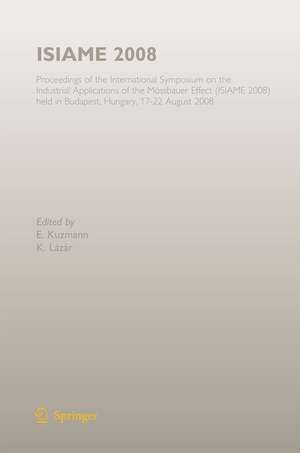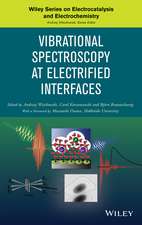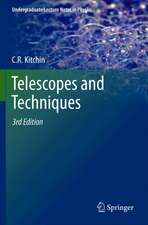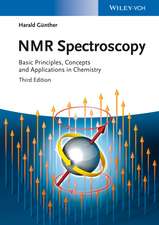ISIAME 2008: Proceedings of the International Symposium on the Industrial Applications of the Mössbauer Effect (ISIAME 2008) held in Budapest, Hungary, 17-22 August 2008
Editat de Ernö Kuzmann, Károly Lázáren Limba Engleză Paperback – 3 dec 2014
E. Kuzmann and K. Lázár (Eds.)
This book provides an excellent overview on the most recent results on the industrial applications of Mössbauer spectroscopy attained on the fields of nanotechnology, metallurgy, biotechnology and pharmaceutical industry, applied mineralogy, energy production industry (coal, oil, nuclear, solar, etc.), computer industry, space technology, electronic and magnetic devices technology, ion implantation technology, including topics like characterization of novel construction materials, electronic components and magnetic materials, composite materials, colloids, amorphous and nanophase materials, small particles, coatings, interfaces, thin films and multilayers, catalysis, corrosion, tribology, surface modification, hydrogen storage, ball milling, radiation effects, electrochemistry, batteries, etc. From the various reports a broad overview emerges illustrating that the method can successfully be applied in a wide variety of topics.
| Toate formatele și edițiile | Preț | Express |
|---|---|---|
| Paperback (1) | 1830.65 lei 43-57 zile | |
| Springer Berlin, Heidelberg – 3 dec 2014 | 1830.65 lei 43-57 zile | |
| Hardback (1) | 1836.94 lei 43-57 zile | |
| Springer Berlin, Heidelberg – 16 iul 2009 | 1836.94 lei 43-57 zile |
Preț: 1830.65 lei
Preț vechi: 2232.50 lei
-18% Nou
Puncte Express: 2746
Preț estimativ în valută:
350.30€ • 366.66$ • 291.56£
350.30€ • 366.66$ • 291.56£
Carte tipărită la comandă
Livrare economică 31 martie-14 aprilie
Preluare comenzi: 021 569.72.76
Specificații
ISBN-13: 9783642420726
ISBN-10: 3642420729
Pagini: 612
Ilustrații: XII, 593 p.
Dimensiuni: 155 x 235 x 32 mm
Greutate: 0.84 kg
Ediția:2009
Editura: Springer Berlin, Heidelberg
Colecția Springer
Locul publicării:Berlin, Heidelberg, Germany
ISBN-10: 3642420729
Pagini: 612
Ilustrații: XII, 593 p.
Dimensiuni: 155 x 235 x 32 mm
Greutate: 0.84 kg
Ediția:2009
Editura: Springer Berlin, Heidelberg
Colecția Springer
Locul publicării:Berlin, Heidelberg, Germany
Public țintă
ResearchCuprins
Preface (ISIAME 2008).- Mössbauer spectroscopy in molecular magnetism.- Monitoring by Mössbauer spectroscopy the thermal reduction of hematite into magnetite: the surface effect and charge disproportionality in iron oxide nanoparticles.- Iron in the brain.- Analysis of powder particles of high carbon cast iron after air plasma spraying.- Ion bombardment of Fe-based amorphous metallic alloys.- Sigma phase—one of the main reasons for deterioration of stainless steels properties.- Chemical aspects of lifetime extension at Paks Nuclear Power Plant.- Magnetic phase transitions in nanoclusters and nanostructures.- Effect of particle size and alloying with different metals on 57Fe Mössbauer spectra.- Characterization of magnetic iron oxide nanoparticles.- Formation of graphite encapsulated iron nanoparticles during mechanical activation and annealing analyzed by Mössbauer spectroscopy.- Hydrogenation of FeCoZr–Al2O3 nanocomposites studied by Mössbauer spectroscopy and magnetometry.- Mössbauer study of rapidly solidified Al-Fe based amorphous alloys.- Integral low-energy electron Mössbauer spectroscopic studies of the surfaces of carbon nanotube-nanocomposite powders.- Microwave absorption and Mössbauer studies of Fe3O4 nanoparticles.- Studies of oxidation of iron nanowires encased in porous aluminium oxide template.- Influence of Mn-for-Fe substitution on structural properties of synthetic goethite.- Synthesis and magnetic properties of Cu0.5Ni0.5Fe2O4 nanoparticles produced by glycothermal and hydrothermal processes.- Mössbauer spectroscopy study of iron oxide nanoparticles obtained by spray pyrolysis.- Solid-state synthesis of ?-Fe and iron carbide nanoparticles by thermal treatment of amorphous Fe2O3.- ILEEMS of thin ?-Fe2O3 films prepared by RF sputtering.-The Mössbauer spectroscopy studies of matrix changes during continuous heating from as-quenched state of high carbon tool steel.- Mössbauer and magnetic studies of nanosize (Fe,Co) x C1???x alloys.- Ball milling induced interstitial atoms redistributions revealed by Mössbauer effect in Fe based alloys.- Mössbauer spectroscopic investigation of retained-austenite content of high-carbon tool steel during isothermal tempering of as-quenched samples.- Feature of solid–liquid metals reaction revealed by conversion electron Mössbauer spectrometry.- Synthesis of Fe carbides species by reactive milling.- The fate of Fe3+ ions in the system {AlO(OH)-xerogel/Fe-compounds} after mechanical activation and different thermal treatments studied by Mössbauer, ESR spectroscopy and thermal analysis.- Characterization of rapidly solidified powder of high-speed steel.- Gummic acid stabilized ?-Fe2O3 aqueous suspensions for biomedical applications.- Iron containing vitamins and dietary supplements: control of the iron state using Mössbauer spectroscopy with high velocity resolution.- Mobility of inorganic nanoparticles in soft matter.- Nanoscaled biocompatible magnetic drug-delivery system: preparation and characterization.- Mössbauer spectroscopic study of sulphonated poly(ether-urethane) linear ionomer doped with iron species.- Mössbauer characterisation of Fe–polygalacturonate as a medicine for human anaemia: the effect of iron concentration.- The characterisation of three different coal samples by means of various analytical techniques.- Mössbauer studies of raw materials from Misti volcano of Arequipa (Peru) for its potential application in the ceramic field.- Mössbauer study of Fe3+/Fe2+ ratio in amphiboles to search correlation with hydrogen isotopefractionation.- Various stages of oxidation of chlorite as reflected in the Fe2?+? and Fe3?+? proportions in the Mössbauer spectra of minerals in Boda Claystone.- Iron–nickel alloy from iron meteorite Chinga studied by Mössbauer spectroscopy with high velocity resolution.- Temperature dependence of the hyperfine parameters of the iron bearing phases in the Mössbauer spectra collected by the Mars Exploration Rover Spirit.- Mössbauer study of the Boom clay, a geological formation for the storage of radioactive wastes in Belgium.- Mössbauer effect study of fly and bottom ashes from an electric generating plant.- Iron Mössbauer redox and relation to technetium retention during vitrification.- 57Fe Mössbauer study of sol–gel synthesized Sn1???x???y Fe x Sb y O2???? powders.- Exchange-spring magnets based on L10-FePt ordered phase.- Mössbauer spectroscopy study of interfaces for spintronics.- Study of rapid stress annealed nano-crystalline Fe74.5Cu1Nb3Si15.5B6 alloy.- Characterization of magnetic nano-fluids via Mössbauer spectroscopy.- Determination of foreign phases in Fe–As based superconducting systems.- Detailed Mössbauer study of the cation distribution in CoFe2O4 ferrites.- Substitution effect of Ba at the Sr sites in Sr(Fe,Re)O3.- Fe(II) spin-crossover compounds based on the extremely versatile ligand system of 1-substituted tetrazoles: a comparative study.- Characterization of magnetite nanoparticles supported in sulfonated styrene-divinylbenzene mesoporous copolymer.- Origin of ferromagnetism in iron implanted rutile single crystals.- Magnetic phase transition of the bond random mixed compound Fe(Br x I1???x )2.- Effects of B and P content on structural and magnetic properties of cast iron based amorphous alloys.-Mössbauer study of Fe in GaAs following 57Mn?+? implantation.- Iron films produced by an arc plasma gun.- Interface mixing in Fe–B–Ag multilayers.- Spin configurations and interfacial diffusion in exchange bias and spin valve systems with Ir–Mn antiferromagnetic pinning layers.- Interfacial microstructure and properties of dissimilar steels joined by high energy beam melting processes.- Iron oxide modified minerals.- Nano-structure analysis of Fe implanted SnO2 films by 57Fe and 119Sn CEMS.- Surface effects in ?-Fe2O3 nanoparticles studied by ILEEMS and TMS.- The structure and composition of novel electrodeposited Sn–Fe and Sn–Co–Fe alloys from a flow circulation cell system.- Study of Au/SnO x –Al2O3 catalysts used in CO oxidation by in situ Mössbauer spectroscopy.- Comparison of Fe-AlPILC and Fe-ZSM-5 catalysts used for degradation of methomyl.- Dissolution behaviour of iron silicate glass.- Structural studies of iron in vitrified toxic wastes.- Formation and characterization of boride coatings thermochemically grown on the Fe64Ni36 alloy.- Characterization of initial atmospheric corrosion of conventional weathering steels and a mild steel in a tropical atmosphere.- Mössbauer and infrared spectroscopy as a diagnostic tool for the characterization of ferric tannates.- Failure analysis of magnets in a servomotor by Mössbauer and X-ray diffraction.- The method of invariants applied to the analysis of 57Fe Mössbauer spectra.- A versatile gas-flow proportional counter for Mössbauer spectroscopy.
Textul de pe ultima copertă
Proceedings of the International Symposium on the Industrial Applications of the Mössbauer Effect (ISIAME 2008) held in Budapest, Hungary, 17-22 August 2008
E. Kuzmann and K. Lázár (Eds.)
This book provides an excellent overview on the most recent results on the industrial applications of Mössbauer spectroscopy attained on the fields of nanotechnology, metallurgy, biotechnology and pharmaceutical industry, applied mineralogy, energy production industry (coal, oil, nuclear, solar, etc.), computer industry, space technology, electronic and magnetic devices technology, ion implantation technology, including topics like characterization of novel construction materials, electronic components and magnetic materials, composite materials, colloids, amorphous and nanophase materials, small particles, coatings, interfaces, thin films and multilayers, catalysis, corrosion, tribology, surface modification, hydrogen storage, ball milling, radiation effects, electrochemistry, batteries, etc. From the various reports a broad overview emerges illustrating that the method can successfully be applied in a wide variety of topics.
E. Kuzmann and K. Lázár (Eds.)
This book provides an excellent overview on the most recent results on the industrial applications of Mössbauer spectroscopy attained on the fields of nanotechnology, metallurgy, biotechnology and pharmaceutical industry, applied mineralogy, energy production industry (coal, oil, nuclear, solar, etc.), computer industry, space technology, electronic and magnetic devices technology, ion implantation technology, including topics like characterization of novel construction materials, electronic components and magnetic materials, composite materials, colloids, amorphous and nanophase materials, small particles, coatings, interfaces, thin films and multilayers, catalysis, corrosion, tribology, surface modification, hydrogen storage, ball milling, radiation effects, electrochemistry, batteries, etc. From the various reports a broad overview emerges illustrating that the method can successfully be applied in a wide variety of topics.










